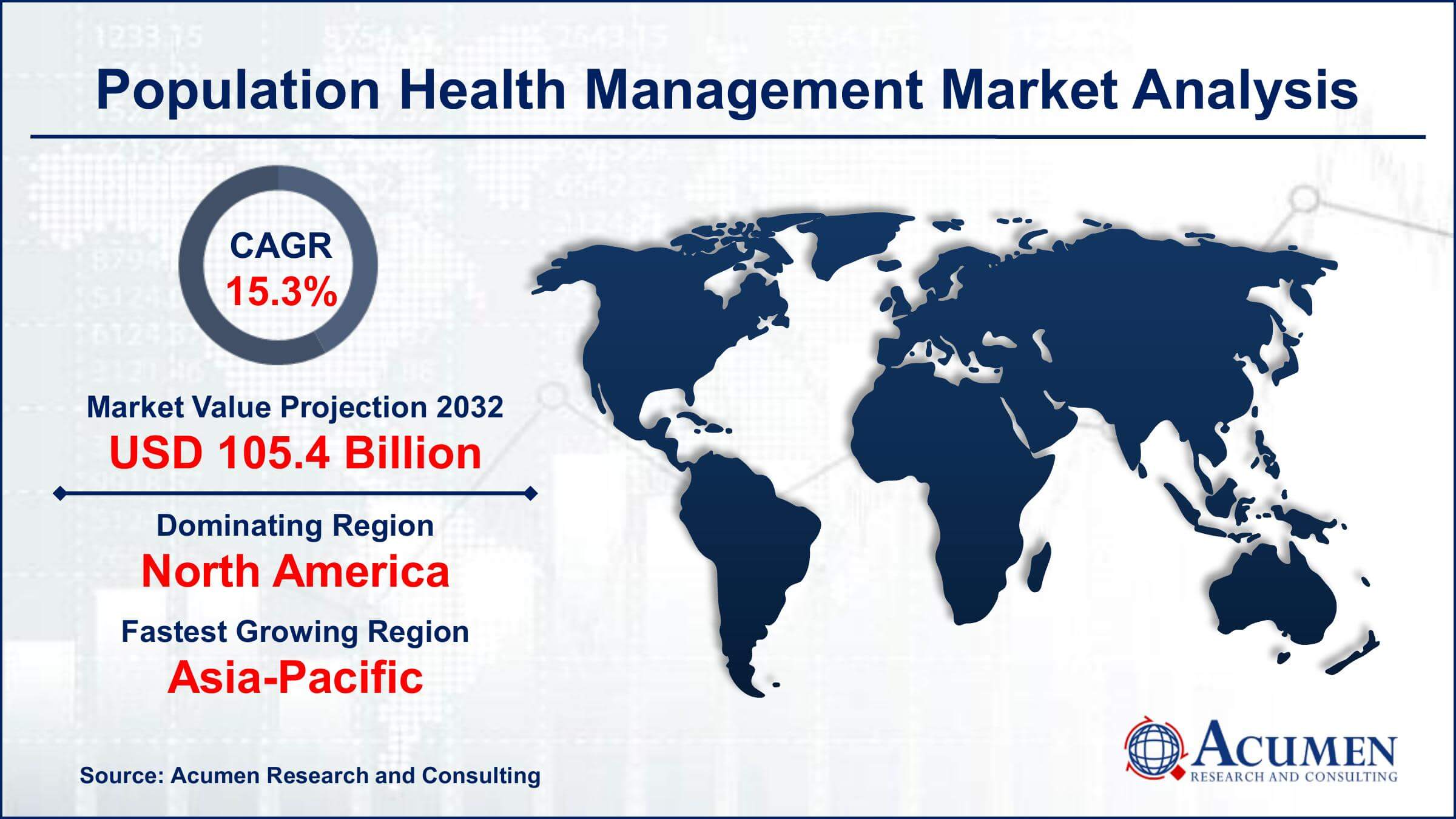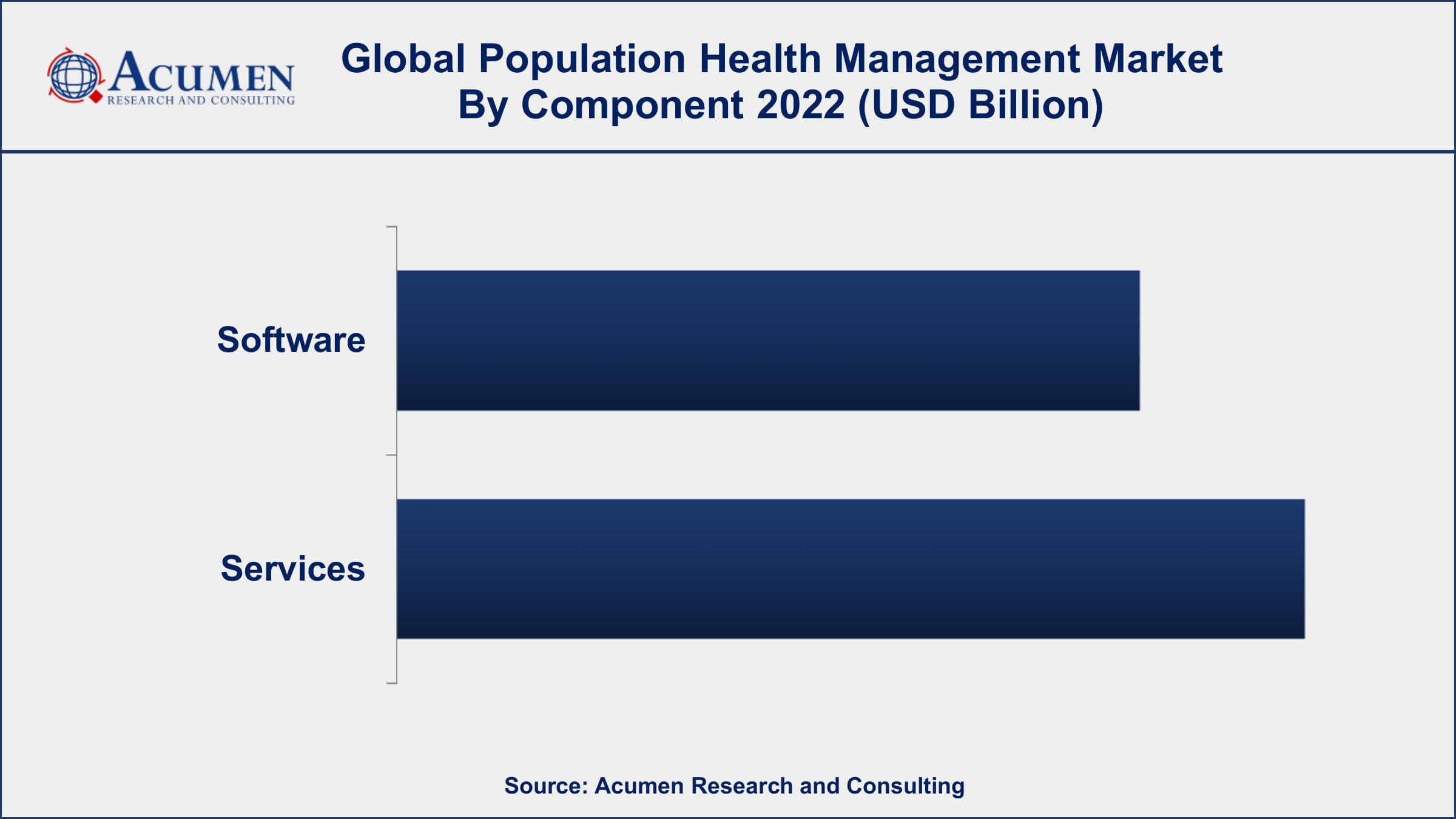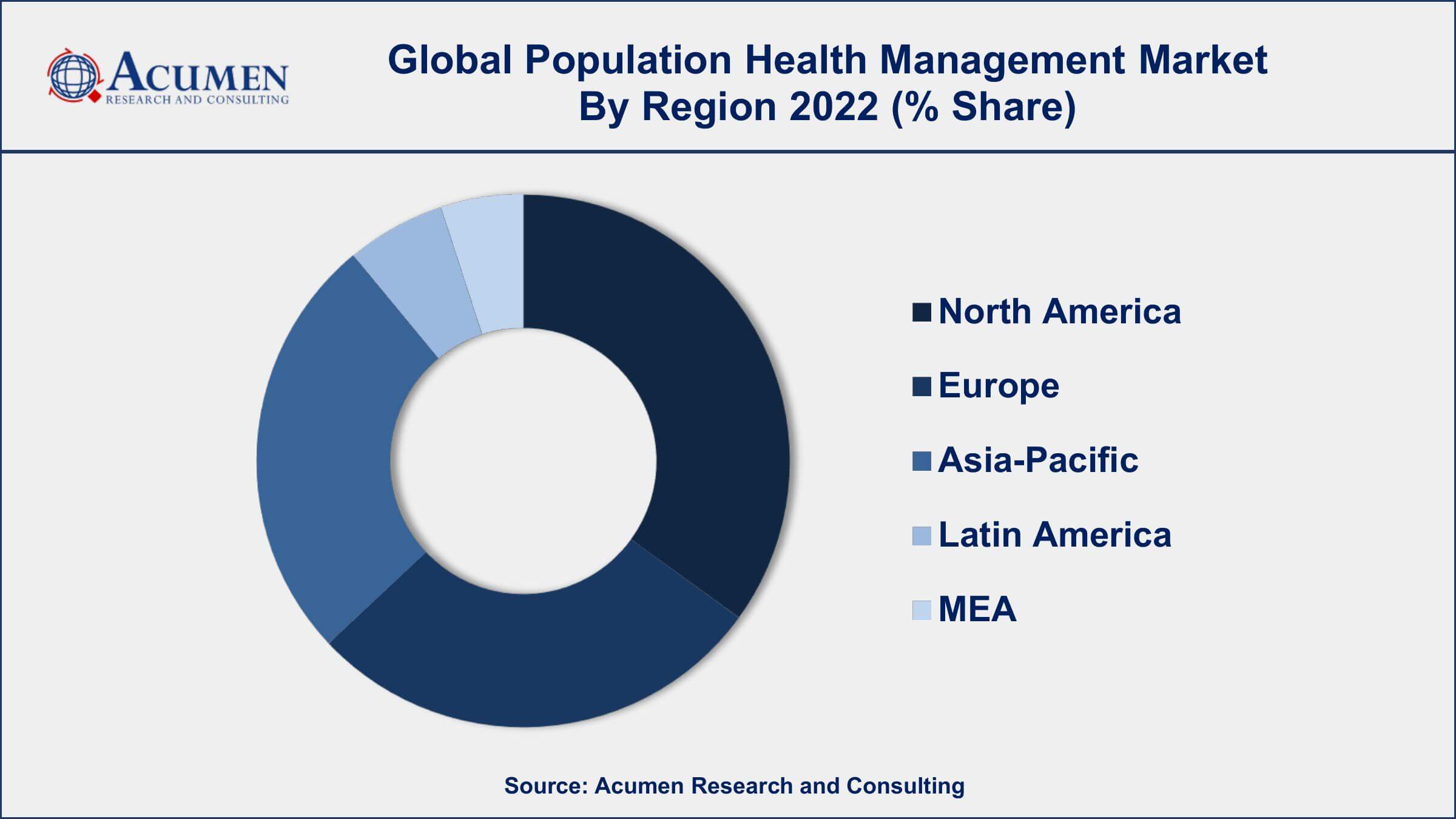Population Health Management Market | Acumen Research and Consulting
Population Health Management Market Size - Global Industry, Share, Analysis, Trends and Forecast 2023 - 2032
Published :
Report ID:
Pages :
Format : ![]()
The Global Population Health Management Market Size accounted for USD 25.9 Billion in 2022 and is projected to achieve a market size of USD 105.4 Billion by 2032 growing at a CAGR of 15.3% from 2023 to 2032.
Population Health Management Market Key Highlights
- Global population health management market revenue is expected to increase by USD 105.4 Billion by 2032, with a 15.3% CAGR from 2023 to 2032
- North America region led with more than 45% of population health management market share in 2022
- According to a study by the Healthcare Financial Management Association, population health management programs can reduce healthcare costs by 5% to 15%.
- According to a survey by the Healthcare Information and Management Systems Society (HIMSS), 92% of healthcare organizations in the US have adopted some form of population health management solution
- According to the Centers for Disease Control and Prevention (CDC), in 2019, chronic diseases accounted for 90% of healthcare spending in the United States
- The cloud-based mode of delivery is the fastest-growing segment of the PHM market
- Rising adoption of healthcare IT solutions, drives the population health management market value

Population health management (PHM) is an approach to healthcare that aims to improve the health outcomes of a defined population, such as a geographic area or a group of patients with a particular health condition. This is achieved by integrating data from multiple sources, including electronic health records, claims data, and social determinants of health, to identify and address health issues proactively. PHM involves the use of technology and analytics to identify at-risk populations, provide targeted interventions, and track progress toward improved health outcomes. It also emphasizes the importance of patient engagement and care coordination across healthcare settings.
The global population health management market is expected to experience significant growth in the coming years. The factors driving the growth of the PHM market include the increasing burden of chronic diseases, the growing demand for value-based care, and the need to reduce healthcare costs. The adoption of healthcare IT solutions, such as electronic health records and population health analytics, is also contributing to the population health management market growth. The COVID-19 pandemic has also had a significant impact on the PHM market, accelerating the adoption of telehealth and remote monitoring solutions, and highlighting the importance of population health management in controlling the spread of infectious diseases.

Global Population Health Management Market Trends
Market Drivers
- Growing prevalence of chronic diseases
- Increasing demand for value-based care
- Need to reduce healthcare costs
- Rising adoption of healthcare IT solutions
- Increasing government initiatives and funding
Market Restraints
- Lack of standardization of data formats and regulatory issues
- Data privacy and security concerns
Market Opportunities
- Emergence of telehealth and remote patient monitoring
- Growing demand for cloud-based solutions
Population Health Management Market Report Coverage
| Market | Population Health Management Market |
| Population Health Management Market Size 2022 | USD 25.9 Billion |
| Population Health Management Market Forecast 2032 | USD 25.9 Billion |
| Population Health Management Market CAGR During 2023 - 2032 | 15.3% |
| Population Health Management Market Analysis Period | 2020 - 2032 |
| Population Health Management Market Base Year | 2022 |
| Population Health Management Market Forecast Data | 2023 - 2032 |
| Segments Covered | By Component, By Delivery Mode, By End User, And By Geography |
| Regional Scope | North America, Europe, Asia Pacific, Latin America, and Middle East & Africa |
| Key Companies Profiled | Cerner Corporation, McKesson Corporation, Allscripts Healthcare Solutions, Inc., Optum, Inc., IBM Corporation, Conifer Health Solutions, LLC, Evolent Health, Inc., Health Catalyst, Inc., Philips Healthcare, Epic Systems Corporation, Medecision, Inc., and Athenahealth, Inc. |
| Report Coverage |
Market Trends, Drivers, Restraints, Competitive Analysis, Player Profiling, Covid-19 Analysis, Regulation Analysis |
Population health management helps in improving and monitoring the health and identification of individual patients within a group. It aggregates data and provides a comprehensive picture of each patient, thereby improving clinical and financial outcomes. The market for population health management is expected to witness growth during the forecast period. Major factors driving the growth are the growing need to minimize healthcare costs, and improve patient services, hence optimizing efficiency as well as revenue.
The market for population health management is growing at a moderate pace. The rising healthcare cost is the biggest issue that most countries are facing. Developing as well as developed regions are struggling to address cost-effective and quality care. Moreover, political instability, economic stress, and lack of proactive initiatives are questioning healthcare funding. Despite health funding and insurance programs, there has been a constant increase in healthcare costs in the U.S., influencing healthcare providers. Healthcare expenditure in the U.S. is around 2.4 times higher than the global average and is anticipated to increase by 68.0% in the coming ten years. With the help of population health management software and services, providers are now able to offer the right treatment and coordinated care across the population at an effective price, thus reducing the overall treatment cost. However, data privacy issues and a lack of skilled professionals are a few factors, which might hinder the growth of the market in the long run.
Population Health Management Market Segmentation
The global population health management market segmentation is based on component, delivery mode, end user, and geography.
Population Health Management Market By Component
- Software
- Services

According to the population health management industry analysis, the services segment accounted for the largest market share in 2022. The services segment includes consulting, implementation, and training services for healthcare organizations looking to adopt and implement PHM solutions. The services segment is an important part of the PHM market, as it helps healthcare organizations to effectively integrate and utilize PHM solutions to improve patient outcomes, reduce costs, and enhance population health. Consulting services, in particular, are expected to see significant growth in the PHM market. As healthcare organizations look to implement PHM solutions, they often require consulting services to help them identify their population health management needs, select appropriate solutions, and develop implementation and adoption strategies.
Population Health Management Market By Delivery Mode
- On-Premise
- Cloud-based
In terms of delivery modes, the cloud-based segment is expected to witness significant growth in the coming years. The cloud-based solutions enable healthcare organizations to collect, manage, and analyze patient health data from multiple sources. Cloud-based solutions offer several advantages over traditional on-premise solutions, including lower costs, greater flexibility, and improved scalability. One of the key drivers of growth in the cloud-based segment of the PHM market is the shift toward value-based care models. Value-based care emphasizes the delivery of high-quality, cost-effective care that is focused on improving patient outcomes. Cloud-based PHM solutions enable healthcare organizations to collect and analyze data from multiple sources, including EHRs, claims data, and patient-generated data, to identify patients who are at risk of poor health outcomes and develop targeted interventions to improve their health.
Population Health Management Market By End User
- Healthcare Providers
- Healthcare Payers
- Others
According to the population health management market forecast, the healthcare payers segment is expected to witness significant growth in the coming years. The healthcare payers include insurance companies, government payers, and other organizations that provide payment for healthcare services. These payers are increasingly adopting PHM solutions to improve the health outcomes of their covered populations and reduce healthcare costs. Healthcare payers are also adopting PHM solutions to support healthcare consumerism. As patients become more engaged in their care and take a more active role in managing their health, payers are investing in PHM solutions that can help patients make more informed decisions about their care and manage their health more effectively.
Population Health Management Market Regional Outlook
North America
- U.S.
- Canada
Europe
- U.K.
- Germany
- France
- Spain
- Rest of Europe
Asia-Pacific
- India
- Japan
- China
- Australia
- South Korea
- Rest of Asia-Pacific
Latin America
- Brazil
- Mexico
- Rest of Latin America
The Middle East & Africa
- South Africa
- GCC Countries
- Rest of the Middle East & Africa (ME&A)

Population Health Management Market Regional Analysis
North America is dominating the population health management (PHM) market due to several factors, including the presence of a well-established healthcare infrastructure, strong government support for healthcare IT adoption, and a high level of healthcare spending. The region has been an early adopter of PHM solutions, with many healthcare organizations and payers in the region leveraging these solutions to improve patient outcomes, reduce costs, and enhance population health. One of the key factors driving the growth of the PHM market in North America is the presence of a well-established healthcare infrastructure. The region has a highly developed healthcare system, with a large number of hospitals, clinics, and other healthcare providers. This has created a strong demand for PHM solutions that can help healthcare organizations to manage and analyze large volumes of patient data and improve care coordination.
Population Health Management Market Player
Some of the top population health management market companies offered in the professional report include Cerner Corporation, McKesson Corporation, Allscripts Healthcare Solutions, Inc., Optum, Inc., IBM Corporation, Conifer Health Solutions, LLC, Evolent Health, Inc., Health Catalyst, Inc., Philips Healthcare, Epic Systems Corporation, Medecision, Inc., and Athenahealth, Inc.
Frequently Asked Questions
What was the market size of the global population health management in 2022?
The market size of population health management was USD 25.9 Billion in 2022.
What is the CAGR of the global population health management market from 2023 to 2032?
The CAGR of population health management is 15.3% during the analysis period of 2023 to 2032.
Which are the key players in the population health management market?
The key players operating in the global market are including Cerner Corporation, McKesson Corporation, Allscripts Healthcare Solutions, Inc., Optum, Inc., IBM Corporation, Conifer Health Solutions, LLC, Evolent Health, Inc., Health Catalyst, Inc., Philips Healthcare, Epic Systems Corporation, Medecision, Inc., and Athenahealth, Inc.
Which region dominated the global population health management market share?
North America held the dominating position in population health management industry during the analysis period of 2023 to 2032.
Which region registered fastest CAGR from 2023 to 2032?
Asia-Pacific region exhibited fastest growing CAGR for market of population health management during the analysis period of 2023 to 2032.
What are the current trends and dynamics in the global population health management industry?
The current trends and dynamics in the population health management industry include growing prevalence of chronic diseases, increasing demand for value-based care, and rising adoption of healthcare IT solutions.
Which component held the maximum share in 2022?
The services component held the maximum share of the population health management industry.



